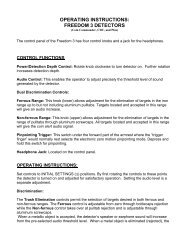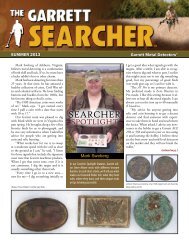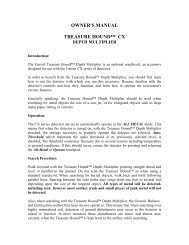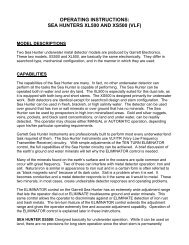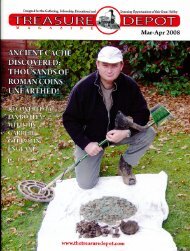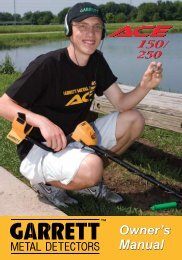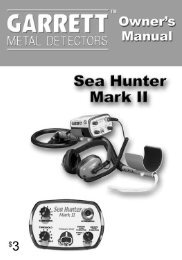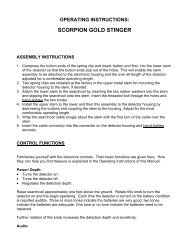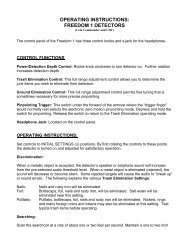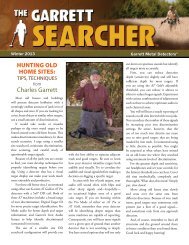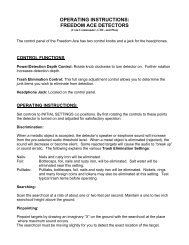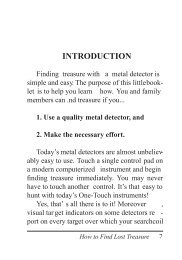Grand Master Hunter® II - Garrett
Grand Master Hunter® II - Garrett
Grand Master Hunter® II - Garrett
Create successful ePaper yourself
Turn your PDF publications into a flip-book with our unique Google optimized e-Paper software.
AFTER TEN HOURS: At this point, you have probably noticed some conflicting meterreadings in areas with a great deal of metal trash, especially when the meter attempted toanalyze two or more targets. Further operating experience with target identification systemswill help you understand more about these so-called false readings.CONTROL FUNCTIONSTouchpadsFamiliarize yourself with the touchpad and knob controls. Their basic functions are given here.How they can help you find treasure is explained in the Operating Instructions of this Manual.ON – BATT CK:Raise searchcoil approximately two feet above the ground. Press the ON touchpad once, andthe <strong>Grand</strong> <strong>Master</strong> begins operating. Approximately three seconds is required to check thebatteries, and their condition is indicated on the meter. While the detector is operating, batterycondition can be checked at any time by pressing and releasing this pad. Each time thedetector is turned on, the battery condition is reported. When the <strong>Grand</strong> <strong>Master</strong> is turned on, itautomatically begins operations in the Discriminate mode.ALL METAL:This touchpad serves a dual function. When pressed and released, it places the detector inthe All Metal Mode. When pressed and held firmly, the second function, Fast Track, isactivated. As you begin scanning with the searchcoil in a normal manner, ground balanceadjustment is quickly and automatically achieved. Release the touchpad after a double tone isheard. Now, the automatic Ground Track system takes over. No further adjustment isnecessary, no matter what level of ground mineralization is encountered.PINPOINT - DEPTH:Press and hold to activate the pinpointing function of your <strong>Grand</strong> <strong>Master</strong> when you havediscovered a target. A complete discussion of pinpointing can be found in the OperatingInstructions section of these instructions. After you have pinpointed a target and released thistouchpad, the meter will indicate the depth of coin-sized targets, and the reading will be highlyaccurate regardless of the size coil being used. This reading holds for approximately three (3)seconds. The <strong>Grand</strong> <strong>Master</strong> Hunter then returns automatically to the operating modepreviously selected with the audio threshold you have already set.DISC:Press to return to the Discriminate Mode when you have been operating in the All Metal mode.The detector begins operating in the Discriminate mode whenever it is turned on.OFF:Press to turn the <strong>Grand</strong> <strong>Master</strong> off. Special memory circuitry will retain all setting (exceptSecondary Functions described later in these instructions. The detector will switch itself offautomatically when no touchpad is pushed and no target is detected during a period of 10minutes.Control Functions
Side PanelIt is recommended that both Multi-Range Discrimination controls be set at the Initial Settings(∆).FERROUS:Rotate to eliminate response to bottlecaps, iron, foil and other similarly conductive metals. Allobjects indicated on the panel to the left of the pointer will not be detected audibly; all objectsto the right will be detected and announced with an audible sound.NON-FERROUS:Rotate to eliminate responses to aluminum pull tabs, screw tops and other objects of similarlyconductive metals. All objects indicated on the panel to the left of the pointer will not bedetected audibly; all objects to the right will be detected and announced with an audible sound.DETECTION DEPTH:Press touchpads to regulate the depth to which your detector will operate effectively. Althoughthe instrument’s maximum depth is always desired, this is usually not feasible because of thetype of soil over which you are scanning and other conditions. Ground mineralization andother conditions can inhibit the detector’s ability to interpret target information. Thesetouchpads permit you to achieve the maximum depth possible in relation to existing conditions.Press (+) to increase detection depth; press (-) to decrease. A single touch and releasechanges the level in a small increment; a continuous pressing results in a continuous levelchange. The meter pointer indicates level (minimum to maximum) on the “0-to100” scale.Minimum detection depth is 25; maximum is 100. All Metal mode permits 4 depth settings;Discriminate mode permits 32 settings. These touchpads adjust the depth in either mode thathas been selected.AUDIO PITCH:Press to adjust the audio to preferred pitch or tone. Touching the (+) pad will raise the toneinto the higher treble range, while touching the (-) pad will lower the pitch to a bass tone.Experiment to determine which pitch best suits your hearing.AUDIO THRESHOLD:Press to regulate the threshold of sound constantly being produced by the <strong>Grand</strong> <strong>Master</strong> as itscans. It is recommended that you always operate the instrument at a minimum level of soundwhich will increase sharply when a target is encountered. Regulate the threshold level with the(+) and (-) touchpads. When headphones are used, it will be usually be necessary to decreasethe threshold level since sound is more audible through headphones.HEADPHONE JACK:Remove rubber plug to connect headphones; always leave plug in place when headphonesare not in use.DISC. AUDIO SELECT:These controls determine the sound that will be made by targets encountered while operatingin the Discriminate mode. Press to change from one audio mode to another. Experiment withall three sounds to select the one most comfortable for your style of hunting.
BELLTONE:When selected, all targets accepted in the non-ferrous discrimination range (including mostcoins) will produce a coin alert bell-like tone. All other accepted targets produce the standardaudio response tone.STANDARD:When selected, all accepted targets will produce the same audio response.BI-LEVEL:When selected, two distinctly different audio responses are produced. Targets accepted in thenon-ferrous discrimination range will produce the standard audio tone. Targets accpeted in theferrous range will be identified with a tone of a distinctly lower pitch.GROUND BALANCE:These touchpads are functional only in the All Metal Mode. AUTO RESET activates thecomputer ground soil analysis and automatically adjusts internal circuitry to cancel the effectsthat mineralized soil has on the detector. When more precise ground balancing is required,the touchpads marked + and – allow overriding of the automatic circuitry as explained underthe heading “To Ground Balance” in the Operating Instructions section.Secondary Functions: It is suggested that you disregard these secondary functions until youhave mastered your <strong>Grand</strong> <strong>Master</strong> and understand all its primary controls. At that time, youcan review the control instructions for these secondary functions and learn their operation.♦ GB: Ground balance♦ VOL: Volume control♦ AUTO/MAN: Threshold regulationThese functions are for use only in highly specialized applications. Because it is quite possiblethat you will seldom require their use, you may not be concerned with them. You will want tounderstand, however, how they relate to the operation of the <strong>Grand</strong> <strong>Master</strong>. A completeexplanation of these secondary functions can be found later in the Operating Instructionssection.CONTROL FUNCTIONSMeterThe <strong>Grand</strong> <strong>Master</strong> Hunter’s Target Identification Meter provides extensive visual information tothe detector operator. Four bands of information plus Battery Check provide the operator withintelligence on ground minerals, detected targets, internal circuitry, and control adjustmentmonitoring to guide the proper use of the detector.♦ Battery Check is activated every time the ON touchpad is pressed. Battery condition issatisfactory when the needle swings clearly into the Battery section (NiCad forrechargeable batteries). It is time to replace batteries (or recharge rechargeables) whenthe pointer reaches only the 50 to 55 position on the meter.♦ Coin Depth band (just above Battery) reads in inches the depth of coin-sized targets. Thedetector automatically adjusts itself to report this information correctly whenever the
Pinpoint touchpad is pushed and released, regardless of which size Crossfire searchcoil isused. Large or very deep objects may not be accurately measured or identified.♦ Color Band (Iron, Gold, Silver) gives a probable identification of a target, based onrelative conductivity. Coins will respond consistently based upon their metallic alloy. Thisband should be used in association with, not instead of, the Target Identification Band(just above) and the target audio.♦ Target ID Band indicates probable identification of all targets, whether announced by anaudio response or not.♦ 0-to-100 Scale indicates ground conditions and acts as an aid when manually settingground balance (See “To Ground Balance” in Operating Instructions section). It indicatesminimum-to-maximum detection depth settings (don’t confuse with coin depth) andprovides target information based on conductivity of the metal detected. This will becomemore helpful as experience is gained. This scale can also be used for identifying foreigncoins when traveling abroad. Conduct tests and write down approximate readings for thevarious denominations.CONTROL FUNCTIONSFrequency controlThis detector is capable of operating at four different frequencies or channels. Operating your<strong>Grand</strong> <strong>Master</strong> at a different frequency might be necessary when two or more <strong>Grand</strong> <strong>Master</strong>Hunters are being used so close together that they “talk” to one another. The combination oftwo switches permits selection of as many as four different operating frequencies. Outsideinterference can also cause a “warble” sound when the detector is in All Metal Mode. Whensuch a “warble” is heard, push one or both of these switches to change the operatingfrequency of your detector. This shift in frequency will result in no loss of sensitivity or depth.Access: Slide the battery cover back slightly to expose the Frequency Control switches.Adjustment: Flip one or both of the two rocker switches (below the larger opening on theright) to modify the operating frequency of your <strong>Grand</strong> <strong>Master</strong>.CONTROL FUNCTIONSBatteriesThe <strong>Grand</strong> <strong>Master</strong> Hunter utilizes a battery pack which requires six (6) standard orrechargeable “C” cell batteries. When replacements are necessary, it is recommended thatonly high quality standard or rechargeable batteries be used. It is advisable to remove thebattery pack when the detector is not in use, particularly for a period of weeks. A standardbattery pack and optional rechargeable pack can be used interchangeably in the detector. The<strong>Grand</strong> <strong>Master</strong> should operate 15 to 20 hours with carbon or rechargeable batteries and alonger time with alkaline batteries.Checking Condition:Battery condition is reported on the Meter each time the ON touchpad is pressed. Carbon oralkaline batteries will indicate in the 90 to 100 range on the meter when new; rechargeablebatteries will indicate only in the area marked NiCad.
Batteries should be considered weak when they indicate between 50 to 55 on the meter. Theyshould be replaced when the meter reports them below 50 or when the detector begins makingtarget-like sounds when no target is encountered.Replacement:1. Slide cover to the rear and remove completely.2. Take out battery pack; it is not connected by wire. It may help to turn the detector upsidedown. Place your hand over the cavity to catch the pack as it slides out.3. Depress four latches to release the top and remove batteries.4. Install batteries. Carefully observe polarity of the batteries.5. Replace cap on pack and insert pack into detector.6. While pressing down on pack, begin sliding in the compartment cover; remove hand andcontinue sliding until it snaps in place.Please note that the <strong>Grand</strong> <strong>Master</strong> will lose Audio Threshold, Audio Tone and Operation ModeSettings when the battery pack is removed from the detector for more than approximately fourminutes.Recharging rechargeables:1. Slide back the battery door to clear the charging jack.2. Plug in the connector and plug charger into a 110v. 60 Hz. power source.3. Charge overnight or a minimum of twelve hours to restore a completely dischargedrechargeable pack. If another voltage source is the only power available, an appropriateconverter must be used. Otherwise, the rechargeable system will be destroyed. Alwaysrecharge rechargeables after six months of non-use.CAUTION: Use only high quality batteries. Do not attempt to recharge non-rechargeablebatteries.OPERATING INSTRUCTIONSTO BEGIN: Follow the instructions in the Starter Phase for turning on your detector andchecking the condition of the batteries. Set your audio threshold as described in ControlFunctions; Side Panel.MODE DESCRIPTIONS:DISCRIMINATE: Each time the <strong>Grand</strong> <strong>Master</strong> Hunter is turned on, it begins operating in theDiscriminate mode. In this mode, you can use the Multi-Range Discrimination control knobson the side panel to eliminate detection of various trash targets. Ground balance is automaticin the Discriminate mode. Most operators will generally prefer to use the Discriminate mode,particularly when coin hunting or searching beaches, parks or playgrounds. To return to thismode when hunting in the All Metal mode, simply press and release the DISC touchpad.ALL METAL: Press and release the ALL METAL touchpad to activate this mode on the <strong>Grand</strong><strong>Master</strong>. You will want to hunt in the All Metal mode when the greatest depth is sought, such aswhen searching for caches or deep relics. Electronic prospecting will also be carried out in thismode. Because no discrimination is possible when using this mode, all metal targets will bedetected. Use of the meter will give an indication of what kind of metal has been detected and
can eliminate some needless digging on shallow targets. Meter identification is less reliable ondeep targets.Fast Track ground balancing is accomplished in this mode by pressing and holding the ALLMETAL touchpad while scanning the searchcoil for only a few seconds in a normal manner.Release the touchpad and Ground Track will continue to track ground minerals and instantlymake all necessary adjustments.When using the All Metal mode, the Secondary Function - GB, Manual Ground Balancing, isalso possible. You may prefer to use this function when searching for gold nuggets or at othertimes when highly mineralized ground is encountered.SETTING DISCRIMINATION: The <strong>Grand</strong> <strong>Master</strong> features dual discrimination controls at theleft end of the Side Panel controls. They offer multiple selectivity and the ability to reject andaccept targets in both the ferrous (iron) and non-ferrous ranges. The two controls split the fullrange of discrimination between ferrous and non-ferrous. Detection of iron objects such asnails, some foil, iron bottlecaps and small pieces of junk is controlled by the knob on the left.The one on the right governs discrimination of such non-ferrous items as aluminum pulltabsand screwcaps.Each of the two controls operates independently. The setting of one has no effect whatsoeveron the other. If you wish to detect all ferrous materials, rotate the left (FERROUS) control tozero (fully counterclockwise). As you advance the control clockwise to higher numbers, moreferrous materials will be rejected. The control operates cumulatively; that is, if you have it setat bottlecap rejection, most nails and some foil will be rejected along with bottlecaps. You areurged not to advance this control farther clockwise than necessary to eliminate thetroublesome ferrous junk material in the ground you are searching.Operate your right (NON-FERROUS) control n the same manner. When it is turned fully to theleft, few of the non-ferrous materials will be rejected. To eliminate pulltabs, rotate the controlclockwise to the suggested setting for them. Keep in mind, however, that there are manydifferent kinds of pulltabs, and some – especially those that are bent or broken – seem to beacceptable to any detector at any setting. Set your controls for those you are finding just in thearea where you are hunting.Your <strong>Grand</strong> <strong>Master</strong> Hunter’s dual discrimination controls offer a greater dynamic adjustmentrange and more resolution which enables you to instruct the detector precisely to rejectspecific junk targets. A most important feature allows you to reject most aluminum pulltabswhile accepting the majority of gold and silver rings. When searching for rings in a pulltabinfestedarea such as a beach, set your non-ferrous control no farther than necessary toeliminate most of the pulltabs. Rings with a higher conductivity and greater mass than pulltabswill be accepted. Remember, however, that some rings will fall into the lower, or ferrous,range. Thus, dual discrimination lets you select rings that register both “above” and “below”pulltab rejection. So, don’t advance either control any further clockwise than absolutelynecessary.GROUND BALANCING: While searching in the All Metal mode, you may find that movementof the searchcoil over the ground causes a noticeable increase or decrease in the soundcoming from your <strong>Grand</strong> <strong>Master</strong>. If so, you may readjust the ground balance of the detector by
pressing and holding the Fast Track touchpad while moving the searchcoil from side to sidethree or four times from one to three inches from the ground. When the sound becomesconstant again, release the pad and your ground balancing is completed.Under unusual conditions, if your audio signal continues to increase or decrease to anydegree, more precise manual ground balancing may be required. You can make thisadjustment using the (+) and (-) pads below the GB on your Side Panel controls. Rememberthat you must press and hold the ALL METAL touchpad to make these manual groundbalancing adjustments.When you determine that manual ground balance is necessary, raise and lower the searchcoiland listen closely to the audio signal. If the sound grow louder, press the (-) button below GBseveral times. Lift your searchcoil again and lower it to operating height. If the sound levelnow decreases, you have made too great a negative adjustment. It will be necessary to pressthe (+) touchpad once or twice. Precise adjustment is possible because there are 256 possiblesteps on the manual ground balance of your <strong>Grand</strong> <strong>Master</strong>. Don’t hesitate to press eachbutton as many times as necessary. Press the proper (+) and (-) touchpads until the audiodoes not change or changes only slightly when the searchcoil is lowered to operating height.Remember that you must hold down the ALL METAL touchpad throughout this manual groundbalancing procedure.When searching extremely mineralized ground, it is recommended that you operate thesearchcoil two inches or more above the ground. You will not lose depth, but will actuallydetect deeper because ground mineral influence is greatly reduced.SEARCHING: Begin your search for coins or other treasure by lowering the searchcoil to aheight of from one to two inches above the ground. Scan in front of you at a speed of one totwo feet per second by moving the searchcoil from side to side in a straight line (not an arc).Always try to maintain a constant height. At the end of each scan path, move the searchcoilforward approximately one-half to two-thirds its diameter and scan a path in the oppositedirection. This overlapping insures that you do not miss targets.When any acceptable target is found, the sound level from the detector’s speaker orheadphones will increase to alert you.TARGET IDENTIFICATION: Target ID and/or conductivity classification of the last target overwhich the searchcoil passed will be indicated on the meter. In most cases, the type of coin willalso be indicated. Encrustation or patina, however, may result in improper classification.The meter will move to the left of “Out of Target ID Range” for the following reasons:1. The target is iron and falls below all items indicated on the meter.2. The target is buried deeper than the identifying range of the meter.3. The target is too small to analyze accurately.4. The target is too large or too near the searchcoil to be analyzed accurately.It is recommended that you always dig any weak or “Out of Range” target. It might be a coinjust at the edge of your searchcoil’s detection range. The Belltone or Bi-Level audio responseswill help identify weak targets in the Discriminate mode.PINPOINTING: Electronic pinpointing offers greater accuracy in target location. When a targetis located, press and hold the PINPOINT touchpad to activate the <strong>Grand</strong> <strong>Master</strong>’s electronic
pinpointing mode. As long as you continue to press the touchpad, the detector will operate inthis mode. When you encounter a target, place the searchcoil near but not above it as youpress and hold the PINPOINT touchpad. Then, move the searchcoil over the target area.When sound is loudest and the meter is at its highest reading, the target will be beneath thecenter of the searchcoil. Release the touchpad, and the meter will indicate the depth of coinsizedobjects as measured from the bottom of the searchcoil. Depth reading is automaticallycalibrated no matter what size Crossfire coil is used. This depth reading will be held for aboutthree seconds. After you release the PINPOINT touchpad, the <strong>Grand</strong> <strong>Master</strong> Hunter willautomatically return to the mode at which you had previously been hunting.Practice pinpointing by placing a coin on the ground. Scan over this coin and use thepinpointing technique. Notice how accurately you pinpoint. You should quickly becomeproficient to within one-quarter of an inch.SEARCHCOILS: The <strong>Grand</strong> <strong>Master</strong> Hunter may be used with all three Crossfire searchcoilsand <strong>Garrett</strong>’s Bloodhound depth multiplier attachment.The 8.5” searchcoil, which provides excellent depth and good scanning width is the mostpopular size used by coin hunters and for general searching over parks, playgrounds andbeaches. For an area known to produce coins, rings and jewelry, this searchcoil should beused for initial searching.The 4.5” “Super Sniper” searchcoil offers the ability to recover coins and other valuable objectsfrom areas with large amounts of buried metal trash or in areas adjacent to such metal asplayground equipment, fences and metal buildings. Since Super Sniper coils have a smallerdiameter, they can detect fewer targets at a time. This eliminates the possible “masking” effectof junk targets. Electronic prospectors can quite effectively use the Super Sniper whensearching for nuggets.The 12.5” diameter searchcoil is useful for large and deep targets such as those normallyencountered in cache and relic hunting. It will also detect coins and other small objects atgreater depths than the smaller coils. Many coin hunters will switch to this size when a faintsignal heard while using a smaller coil indicates a fringe-area target.The Bloodhound depth multiplier attachment eliminates the need for a separate “two-box”detector and multiplies the depth to which your <strong>Grand</strong> <strong>Master</strong> can detect objects that are largerthan a fruit jar. The Bloodhound enables the <strong>Grand</strong> <strong>Master</strong> to detect large targets moredeeply, and is not bothered by small pieces of metal junk – minimizing unnecessary digging.Your <strong>Grand</strong> <strong>Master</strong> will automatically identify that you are using the Bloodhound and will allowyou to select only the All Metal mode. Press the ALL METAL touchpad to return audio to yourpreset threshold.SECONDARY FUNCTIONS:To activate the circuitry that permits regulation of any of these functions, press and hold theALL METAL touchpad. Then, use the (+) and (-) controls below each secondary function listedon the Side Panel for precision adjustment.
GB (Ground Balance): This function will rarely be required since the detector’s internalcircuitry and the Ground Track automatic ground balancing method described in ControlFunctions; Touchpads will usually be highly satisfactory. When manual ground balance isdesired, press and hold the ALL METAL touchpad and use these (+) and (-) as describedunder Ground Balancing in the Operating Instructions.VOL (Volume): This adjustment controls the maximum volume of sound produced by the<strong>Grand</strong> <strong>Master</strong> when a target is encountered. It does not affect the threshold level you havealready selected as the primary audio function of your detector.AUTO/MAN (Threshold Regulation): By holding the ALL METAL touchpad and pressing the(-) touchpad, you select the manual method of regulating audio threshold. Manual retuningmight be required only in extremely trashy areas where numerous unacceptable targets limitthe instrument’s ability to recover quickly enough to accurately report on all targets. Whenusing this function to regulate threshold manually, it may be necessary to press the ALLMETAL touchpad occasionally to maintain a satisfactory threshold level.Depressing and holding the ALL METAL touchpad, then pressing the (+) button returns thethreshold regulation function to automatic.PROFESSIONAL PHASECOIN HUNTING: After studying this Owner’s Manual very carefully, you will be able to performmore tasks with the <strong>Grand</strong> <strong>Master</strong> Hunter and complete them more easily. The following tipsrepresent the experience of a professional with the <strong>Grand</strong> <strong>Master</strong>.Deep coin hunting: For maximum depth and to avoid missing a small or very old coin, setboth DISCRIMINATION controls to absolute zero. This will prevent missing an especially oldcoin that is so oxidized that it will be rejected by any discrimination. If sound becomes erratic,press the (-) DETECTION DEPTH touchpad on the Side Panel several times until the erraticsound disappears. You are now operating at the maximum sensitivity possible under presentground conditions. The 12.5” searchcoil is recommended for seeking extra-deep coins.Caution: When operating on ocean beaches where salt is found, do not attempt to hunt in theAll Metal mode which requires ground balancing. Even though the Discriminate modeautomatically adjusts ground balance, we suggest the FERROUS control be adjusted to theapproximate Bottlecap reject setting. Further, when you are operating at zero discrimination,you are effectively searching in an All Metal mode. You still have the advantage of onemethod of discrimination – the Belltone, which responds only to non-ferrous metal.Hunting in trashy areas: Use of <strong>Garrett</strong>’s 4.5” Super Sniper searchcoil can aid tremendouslyin the search for coins in areas with large accumulations of metal trash. Adjust bothDISCRIMINATION controls to maximum reject – turned fully clockwise to the largest numbers.You will now detect only copper pennies and all silver coins. Press the (-) DETECTIONDEPTH touchpad on the Side Panel until your sensitivity as reported on the Meter is reducedbelow 50%. This will enable you to operate on top of deep metallic trash without detecting it.
By the combination of decreased sensitivity and increased rejection of junk items it is nowpossible to find more coins. Although any size searchcoil will perform in this operatingprocedure, the 4.5” Super Sniper will produce the best results.CACHE & RELIC HUNTING: Operating in the All Metal mode, use the Fast Track method toground balance the detector. Attach a 12.5” searchcoil and adjust DETECTION DEPTHtouchpads on Side Panel for maximum sensitivity possible (without erratic sound). Operatewith the searchcoil approximately four to six inches above the ground (depending on groundmineralization) to eliminate erratic responses from ground minerals and small bits of metal.You will have super sensitivity and detect all targets dime-sized and larger. Caches and relicspreviously missed or overlooked will now be detected easily.ELECTRONIC PROSPECTING: Even though the <strong>Grand</strong> <strong>Master</strong> Hunter is a universal detector,excellent for prospecting, its very low frequency (VLF) circuitry will not detect somemicroscopic gold.Nugget Hunting: Using the 8.5” searchcoil, the Fast Track ground balance system will leavethe <strong>Grand</strong> <strong>Master</strong> slightly positive in relation to the ground. This condition makes detection ofsmall nuggets easier since detectors that adjust slightly negative have a tendency to overlookthe smaller nuggets.Hot Rocks: The <strong>Grand</strong> <strong>Master</strong> will instantly identify both types of “hot rocks” in any searcharea. Test for them in the following manner. Simply adjust both DISCRIMINATION controls tozero settings and scan in the All Metal mode. When you locate a suspected hot rock, pressthe DISC touchpad and release; then pass back over the target. If the target is simply a hotrock, it will not respond. If it has sufficient metal content, it will respond as metal. If it is a largegold nugget or non-ferrous metal, the Belltone will sound. Because small nuggets or othermetallic targets sometimes produce no response in the Discriminate mode, it is advisable touse this mode only to test suspected hot rocks that respond loudly and positively to All Metalscanning.Searchcoil sizes will differ according to the area being searched. If your search area is in adry wash or among large rocks that restrict the use of an 8.5” coil, change to the 4.5” size.When working in areas that have already been searched, your only option is to change to the12.5” searchcoil. You may miss extremely small nuggets with the larger coil, but the increaseddepth and sensitivity will permit you to detect deep nuggets that may have been previouslymissed. Professional nugget hunters know that one nugget of decent size is better thanhundreds of microscopic ones.Alkaline salt is heavily present in some rich nugget hunting areas. Attempts to search suchareas with metal detectors have met with failure over the years because of the difficulty inground balancing. However, by using the 12.5” searchcoil and searching in the Discriminatemode. By setting DISCRIMINATION controls at zero, they ignore salt and detect largenuggets.Test your <strong>Grand</strong> <strong>Master</strong> at zero discrimination with a nugget two pennyweights in size; it willsurprise you. You can advance the FERROUS control to reject many small iron targets andstill read the nugget. On even large nuggets, the Belltone will respond to aid your identificationof gold in relation to small iron targets. Never attempt to operate any large searchcoil too close
to heavy salt or extremely negative ground minerals. Maintain an operating height ofapproximately three to eight inches.OPERATING RECOMMENDATIONSAs you operate and use your <strong>Garrett</strong> detector, you will quickly grow more proficient in its use.It is recommended that you build your own test plot. Bury several items, including a nail, apiece of foil, a pulltab, a bottlecap and several coins at depths of about two to eight inches anda foot apart. Clearly mark the location where each article is buried. Practice scanning thetargets while listening to and studying the detection signals.Remember that newly buried objects, especially coins, will be somewhat more difficult todetect than items that have been buried for some time. This is primarily a metallurgicalphenomenon. Experiment with various settings of the Trash Elimination controls to see howyour detector responds. Practice trying to pinpoint and locate targets precisely.When scanning, do not hurry. Scan the searchcoil at a speed of about one to two feet persecond. Keep the searchcoil flat and level to the ground. Move it back and forth slowly andsteadily while you walk at a pace that is comfortable. Be methodical. Do not skip any areas.Wear headphones for greater sound perception and concentrate on your scanning.After you have operated your <strong>Garrett</strong> detector for only a short time, you will be surprised athow proficient you have become it its use. Do not expect to achieve the greatest accuracy andsuccess, however, until you have operated the detector for at least 100 hours or more.Good hunting!MAINTENANCE Always remember that your <strong>Garrett</strong> detector is a sensitive electronic instrument. It is builtto withstand rugged treatment in the outdoors, but you should always handle the detectoras carefully as possible. Try to avoid temperature extremes as much as possible, such as storing the detector in anautomobile trunk during hot summer months or outdoors in sub-freezing weather. Keep your detector clean. Always wipe the housing after use, and wash the coil whennecessary. Protect your instrument from dust and sand as much as possible. Your searchcoil is submersible. The control housing is not! Never submerge the controlhousing and always protect it from heavy mist, rain or blowing surf. Disassemble the stem and wipe it clean after use in sandy areas. When storing longer that about one month, remove batteries from the detector.REPAIR SERVICE
In case of difficulty, read this Owner’s Manual again thoroughly to make certain your detectoris not inoperable needlessly. Your dealer may also be able to offer advice.When your detector must be returned to the factory for service, always include a letter thatdescribes its problem as fully as possible. Before you return your detector to the <strong>Garrett</strong>factory, make certain: You have read this Owner’s Manual carefully You have checked batteries, switches and connectors. (Check batteries especially closely.They are the most common cause of detector “failure”.) You have checked with your dealer, particularly if you are not familiar with this type of metaldetector. You have included a note with the detector describing the problems you are encounteringwith this detector and conditions under which they occur. Make certain to include yourname, address and a phone number where you can be contacted between 8:30 a.m. and 4p.m., Central Time. You have carefully packed the detector in its original shipping carton or other suitable box.Make certain that proper insulation or packing material is used to keep all parts secure. Donot ship stems or headphones unless they are part of the problem. Be certain to return allcoils, unless the problem is mechanical. Ship to <strong>Garrett</strong> Metal Detectors, 1881 W. State St., Garland, TX 75042. You can call <strong>Garrett</strong>’s Customer Service Department (972-494-6151) if you have furtherquestions. Please allow approximately one week for <strong>Garrett</strong> technicians to examine and repair yourdetector after they receive it, plus another week for return shipping to you. All equipmentwill be returned UPS or parcel post unless written authorization is given by you to shipcollect by air parcel post, UPS Blue (air) or air freight.MIND YOUR MANNERSFilling holes and obeying no trespassing signs are but two requirements of a dedicated metaldetector hobbyist. A sincere request that Charles <strong>Garrett</strong> makes to every user of one of hisdetectors is that each place searched be left in a better condition than it was found.Thousands of individuals and organizations have adopted this formal Metal Detector OperatorsCode of Ethics: I will respect private and public property, all historical and archaeological sites and will dono metal detecting on these lands without proper permission.
I will keep informed on and obey all laws, regulations and rules governing federal, state andlocal public lands. I will aid law enforcement officials whenever possible. I will cause no willful damage to property of any kind, including fence, signs and buildingsand will always fill holes I dig. I will not destroy property, buildings or the remains of ghost towns and other desertedstructures. I will not leave litter or uncovered items lying around. I will carry all trash and dug targetswith me when I leave each search area. I will observe the Golden Rule, using good outdoor manners and conducting myself at alltimes in a manner which will add to the stature and public image of all people engaged inthe field of metal detection.WARNING!Any metal detector may discover underground power lines, explosives or other items whichwhen struck could cause personal injury. When searching for treasure with your <strong>Master</strong>Hunter, observing these precautions: Do not hunt in an area where you believe there may be shallowly buried undergroundelectric lines or pipes. Do not hunt in a military zone where bombs or other explosives may be buried. Avoid striking any line known to be or suspected to be carrying electrical power. Do not disturb any pipeline, particularly if it could be carrying flammable gas or liquid. Use reasonable caution in digging toward any target, particularly in areas where you areuncertain of underground conditions.PATENT PROTECTION: Proof of <strong>Garrett</strong>’s excellence is the recognition given them by thefollowing United States patents: 4,709,213; 4,488,115; 4,700,139; 4,398,104; 4,423,377;4,303,879; 4,334,191; 3,662,255; 4,162,969; 4,334,192; 5,148,151; 5,138,262; 5,721,489;5,786,696; 5,969,528; Design 274,704 and 297,221; Design 333,990; G.B. Design 2,011,852;Australia Design 111,674 and other patents pending.



